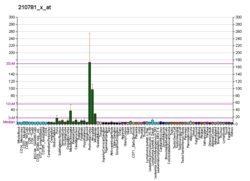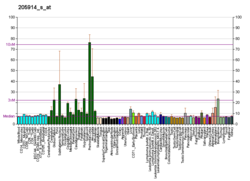Glutamate [NMDA] receptor subunit zeta-1 is a protein that in humans is encoded by the GRIN1 gene.[5][6]
The protein encoded by this gene is a critical subunit of N-methyl-D-aspartate receptors, members of the glutamate receptor channel superfamily which are heteromeric protein complexes with multiple subunits arranged to form a ligand-gated ion channel. These subunits play a key role in the plasticity of synapses, which is believed to underlie memory and learning. The gene consists of 21 exons and is alternatively spliced, producing transcript variants differing in the C-terminus. The sequence of exon 5 is identical in vertebrates, with exon 5 splicing demonstrated in human, mouse and rat.[7][8][9][10] Cell-specific factors are thought to control expression of different isoforms, possibly contributing to the functional diversity of the subunits.[6]
See also
[edit]References
[edit]- ^ a b c GRCh38: Ensembl release 89: ENSG00000176884 – Ensembl, May 2017
- ^ a b c GRCm38: Ensembl release 89: ENSMUSG00000026959 – Ensembl, May 2017
- ^ "Human PubMed Reference:". National Center for Biotechnology Information, U.S. National Library of Medicine.
- ^ "Mouse PubMed Reference:". National Center for Biotechnology Information, U.S. National Library of Medicine.
- ^ Monyer H, Sprengel R, Schoepfer R, Herb A, Higuchi M, Lomeli H, et al. (May 1992). "Heteromeric NMDA receptors: molecular and functional distinction of subtypes". Science. 256 (5060): 1217–1221. Bibcode:1992Sci...256.1217M. doi:10.1126/science.256.5060.1217. PMID 1350383. S2CID 989677.
- ^ a b "Entrez Gene: GRIN1 glutamate receptor, ionotropic, N-methyl D-aspartate 1".
- ^ Sengar AS, Li H, Zhang W, Leung C, Ramani AK, Saw NM, et al. (December 2019). "Control of Long-Term Synaptic Potentiation and Learning by Alternative Splicing of the NMDA Receptor Subunit GluN1". Cell Reports. 29 (13): 4285–4294.e5. doi:10.1016/j.celrep.2019.11.087. PMID 31875540. S2CID 209482250.
- ^ Liu H, Wang H, Peterson M, Zhang W, Hou G, Zhang ZW (October 2019). "N-terminal alternative splicing of GluN1 regulates the maturation of excitatory synapses and seizure susceptibility". Proceedings of the National Academy of Sciences of the United States of America. 116 (42): 21207–21212. Bibcode:2019PNAS..11621207L. doi:10.1073/pnas.1905721116. PMC 6800312. PMID 31570583.
- ^ Herbrechter R, Hube N, Buchholz R, Reiner A (July 2021). "Splicing and editing of ionotropic glutamate receptors: a comprehensive analysis based on human RNA-Seq data". Cellular and Molecular Life Sciences. 78 (14): 5605–5630. doi:10.1007/s00018-021-03865-z. PMC 8257547. PMID 34100982.
- ^ Manta G, Spathis AD, Taraviras S, Kouvelas ED, Mitsacos A (August 2011). "Age and visual experience-dependent expression of NMDAR1 splice variants in rat retina". Neurochemical Research. 36 (8): 1417–1425. doi:10.1007/s11064-011-0467-5. PMID 21499738. S2CID 11853676.
Further reading
[edit]- Lin JW, Wyszynski M, Madhavan R, Sealock R, Kim JU, Sheng M (March 1998). "Yotiao, a novel protein of neuromuscular junction and brain that interacts with specific splice variants of NMDA receptor subunit NR1". The Journal of Neuroscience. 18 (6): 2017–2027. doi:10.1523/JNEUROSCI.18-06-02017.1998. PMC 6792910. PMID 9482789.
- Schröder HC, Perovic S, Kavsan V, Ushijima H, Müller WE (1998). "Mechanisms of prionSc- and HIV-1 gp120 induced neuronal cell death". Neurotoxicology. 19 (4–5): 683–688. PMID 9745929.
- Adriani W, Felici A, Sargolini F, Roullet P, Usiello A, Oliverio A, Mele A (November 1998). "N-methyl-D-aspartate and dopamine receptor involvement in the modulation of locomotor activity and memory processes". Experimental Brain Research. 123 (1–2): 52–59. doi:10.1007/s002210050544. PMID 9835392. S2CID 8388670.
- Dingledine R, Borges K, Bowie D, Traynelis SF (March 1999). "The glutamate receptor ion channels". Pharmacological Reviews. 51 (1): 7–61. doi:10.1016/S0031-6997(24)01394-2. PMID 10049997.
- King JE, Eugenin EA, Buckner CM, Berman JW (April 2006). "HIV tat and neurotoxicity". Microbes and Infection. 8 (5): 1347–1357. doi:10.1016/j.micinf.2005.11.014. PMID 16697675.
- Zimmer M, Fink TM, Franke Y, Lichter P, Spiess J (July 1995). "Cloning and structure of the gene encoding the human N-methyl-D-aspartate receptor (NMDAR1)". Gene. 159 (2): 219–223. doi:10.1016/0378-1119(95)00044-7. PMID 7622053.
- Karp SJ, Masu M, Eki T, Ozawa K, Nakanishi S (February 1993). "Molecular cloning and chromosomal localization of the key subunit of the human N-methyl-D-aspartate receptor". The Journal of Biological Chemistry. 268 (5): 3728–3733. doi:10.1016/S0021-9258(18)53754-6. PMID 7679115.
- Younkin DP, Tang CM, Hardy M, Reddy UR, Shi QY, Pleasure SJ, et al. (March 1993). "Inducible expression of neuronal glutamate receptor channels in the NT2 human cell line". Proceedings of the National Academy of Sciences of the United States of America. 90 (6): 2174–2178. Bibcode:1993PNAS...90.2174Y. doi:10.1073/pnas.90.6.2174. PMC 46048. PMID 7681588.
- Planells-Cases R, Sun W, Ferrer-Montiel AV, Montal M (June 1993). "Molecular cloning, functional expression, and pharmacological characterization of an N-methyl-D-aspartate receptor subunit from human brain". Proceedings of the National Academy of Sciences of the United States of America. 90 (11): 5057–5061. Bibcode:1993PNAS...90.5057P. doi:10.1073/pnas.90.11.5057. PMC 46653. PMID 7685113.
- Magnuson DS, Knudsen BE, Geiger JD, Brownstone RM, Nath A (March 1995). "Human immunodeficiency virus type 1 tat activates non-N-methyl-D-aspartate excitatory amino acid receptors and causes neurotoxicity". Annals of Neurology. 37 (3): 373–380. doi:10.1002/ana.410370314. PMID 7695237. S2CID 24405132.
- Foldes RL, Rampersad V, Kamboj RK (September 1994). "Cloning and sequence analysis of additional splice variants encoding human N-methyl-D-aspartate receptor (hNR1) subunits". Gene. 147 (2): 303–304. doi:10.1016/0378-1119(94)90089-2. PMID 7926821.
- Sheng M, Cummings J, Roldan LA, Jan YN, Jan LY (March 1994). "Changing subunit composition of heteromeric NMDA receptors during development of rat cortex". Nature. 368 (6467): 144–147. Bibcode:1994Natur.368..144S. doi:10.1038/368144a0. PMID 8139656. S2CID 4332025.
- Tingley WG, Roche KW, Thompson AK, Huganir RL (July 1993). "Regulation of NMDA receptor phosphorylation by alternative splicing of the C-terminal domain". Nature. 364 (6432): 70–73. Bibcode:1993Natur.364...70T. doi:10.1038/364070a0. PMID 8316301. S2CID 4322831.
- Foldes RL, Rampersad V, Kamboj RK (September 1993). "Cloning and sequence analysis of cDNAs encoding human hippocampus N-methyl-D-aspartate receptor subunits: evidence for alternative RNA splicing". Gene. 131 (2): 293–298. doi:10.1016/0378-1119(93)90309-Q. PMID 8406025.
- Collins C, Duff C, Duncan AM, Planells-Cases R, Sun W, Norremolle A, et al. (July 1993). "Mapping of the human NMDA receptor subunit (NMDAR1) and the proposed NMDA receptor glutamate-binding subunit (NMDARA1) to chromosomes 9q34.3 and chromosome 8, respectively". Genomics. 17 (1): 237–239. doi:10.1006/geno.1993.1311. PMID 8406459.
- Lannuzel A, Lledo PM, Lamghitnia HO, Vincent JD, Tardieu M (November 1995). "HIV-1 envelope proteins gp120 and gp160 potentiate NMDA-induced [Ca2+]i increase, alter [Ca2+]i homeostasis and induce neurotoxicity in human embryonic neurons". The European Journal of Neuroscience. 7 (11): 2285–2293. doi:10.1111/j.1460-9568.1995.tb00649.x. PMID 8563977. S2CID 27201873.
- Corasaniti MT, Melino G, Navarra M, Garaci E, Finazzi-Agrò A, Nisticò G (September 1995). "Death of cultured human neuroblastoma cells induced by HIV-1 gp120 is prevented by NMDA receptor antagonists and inhibitors of nitric oxide and cyclooxygenase". Neurodegeneration. 4 (3): 315–321. doi:10.1016/1055-8330(95)90021-7. PMID 8581564.
- Ehlers MD, Zhang S, Bernhadt JP, Huganir RL (March 1996). "Inactivation of NMDA receptors by direct interaction of calmodulin with the NR1 subunit". Cell. 84 (5): 745–755. doi:10.1016/S0092-8674(00)81052-1. PMID 8625412. S2CID 1376853.
- Pittaluga A, Pattarini R, Severi P, Raiteri M (May 1996). "Human brain N-methyl-D-aspartate receptors regulating noradrenaline release are positively modulated by HIV-1 coat protein gp120". AIDS. 10 (5): 463–468. doi:10.1097/00002030-199605000-00003. PMID 8724036. S2CID 1669986.







